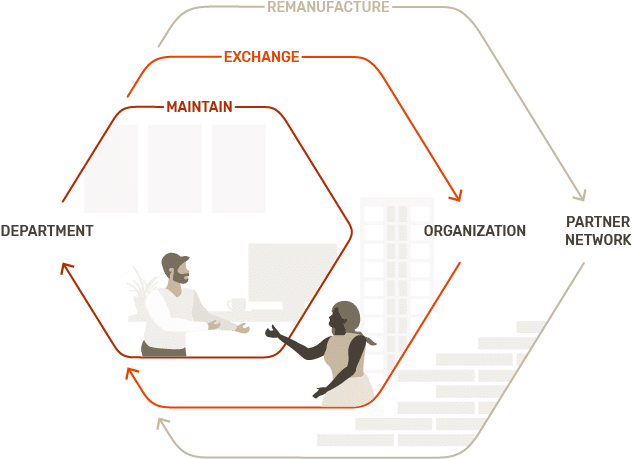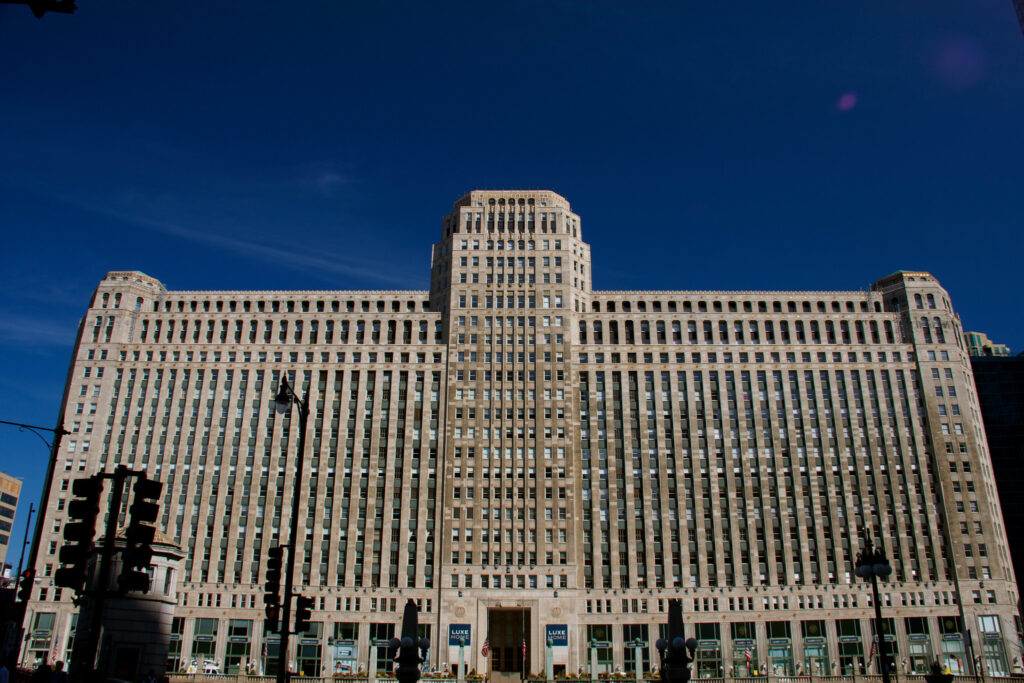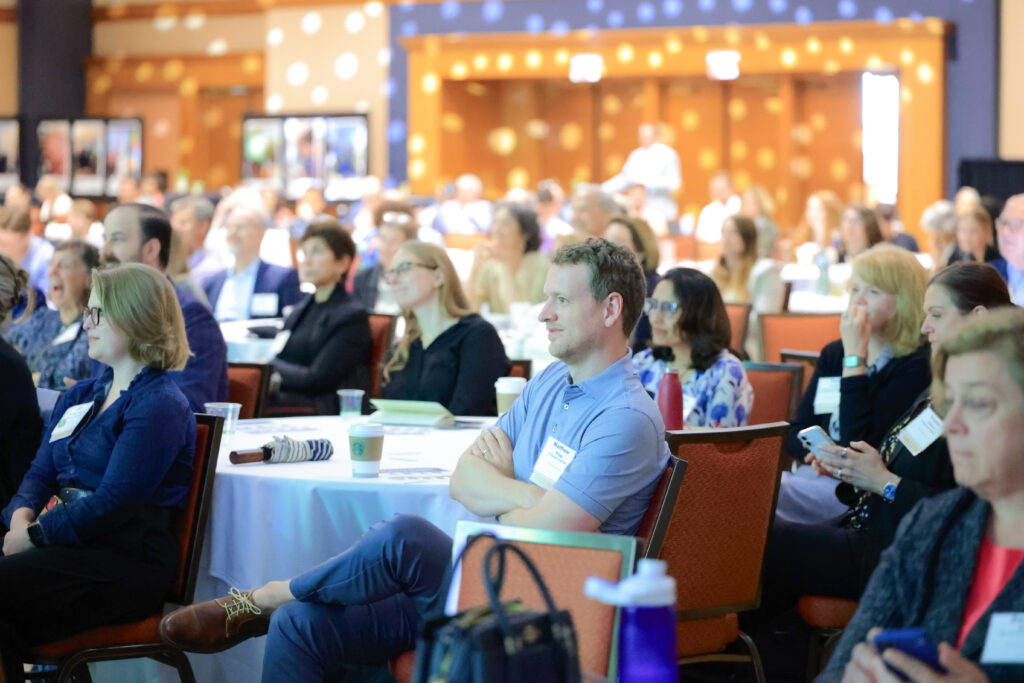For 200+ years, our planet has accepted a linear economic model, where we harvest and extract materials, use them to manufacture some sort of product, and then either our employees or consumers elect to get rid of these items.
It’s easy to understand why this happens. We live in an age of constant innovation within our daily lives. Updates come out daily, apps are launched every week, and new products and technologies are being introduced at an alarming pace. These changes have created a culture in which valuable and accessible assets are often underutilized and consistently replaced with a modified newer version. This leads to the extensive storage of gently used items and assets, or, even worse, their direct disposal to a landfill, resulting in a massive environmental impact. In fact, of all the materials harvested from the Earth every year, we cycle back just 8.6%. Just two years ago, this was a shade over 9%.
According to Forbes, the United States could realize up to $630 billion in savings per year by implementing a circular economy if we could recover these resources.
$630 billion. In savings. Per year.
The Circularity Gap Shift
“The circular economy is based on three principles: designing out waste and pollution, keeping products and materials in use at the highest possible value, and regenerating natural systems.”
– Ellen MacArthur Foundation, Circular Procurement
To rise up and overcome the dangers and challenges of climate change and its ripple effect on communities, businesses need to shift their procurement decisions so that the material outputs of unwanted or idle resources become the inputs in new or repurposed products – by implementing the Circular Economy.
This shift to the circular economy is more than environmental impact. It’s about eliminating waste, but also it’s about maximizing the life-span of materials through innovation and creating the conditions necessary to foster innovation, creativity, and – ultimately – address societal needs.
It’s about creating a sustainable economic model that’s better for the globe and all of its inhabitants.
If we realize what is possible with $630 billion in savings per year, the redistribution of those savings can be directed to the people and places that need it the most. They can be used to incentivize organizations to continuously work to create a better home for our future generations.
And if the best results of our current linear economic model are: hemorrhaging savings each year, negatively impacting our climate, and pushing equitable practices out of reach, perhaps instead of asking ourselves, “Is shifting our procurement model worth it?”, we need to ask ourselves: “Can we afford not to modernize and evolve procurement and shift to a circular model?”
Then we need to have an understanding of what it will take for people to move away from that linear economic system.

The Electric Analog
Looking at the growth of the electric car provides a possible roadmap for circular economic growth longer-term. Mass produced and affordable electric cars were mostly just a dream almost a decade ago – and for some, wishful thinking at best.
Tesla is now a legitimate threat to the German car manufacturers. They are leading the way in creating more sustainable ways of transportation for the masses.
It hasn’t been an overnight phenomenon, though. They have been laying the foundation, and infrastructure, for years in order to be in this position. They then tied sustainability to the best interests of car consumers creating a seismic shift. Similarly, companies like Google, Microsoft and others have begun to apply circular design principles into their day-to-day operations and procurement choices.
Procurement has consistently been overlooked as a pivotal driver in enabling businesses and governments to strive towards a more sustainable and circular economy. Organizations typically buy, prioritizing the act of receiving an item in need without a deeper consideration for how the items are utilized. Where are current items that they could procure to meet that need? What happens to the items when they are decommissioned?
For the most of our capitalistic existence, the take-make-dispose model has driven these entities while they try to provide for their respective consumers and constituents. There is a false sense of expediency and efficiency buried in this approach: where there seems to be ease of access creates mounds of inefficiencies in storage, stock, and waste and where there seems to be demand in quality, there is a loss of liquid revenue.
Rheaply Creates a Connected Circular Economy
To solve these issues, and to tie infrastructural changes to procurement to that incentivizing $630 billion pie, the fastest way to enter the circular economy is to drive better visibility and sharing of idle or unwanted or underutilized resources.
Buy things that you need, and once they serve their purpose, find them (and if needed, their constituent parts) a new home.
But what does a new home really mean? How do you know when an item or asset has served its purpose? Who is permitted to share and receive? How can we make it easier for other organizations and communities who struggle with budget constraints, resource availability, and time to buy? Who will have access to these items and assets?
These are the questions we are asking daily at Rheaply, where we use technology to help world-leading businesses and governments find and share physical assets and resources that would otherwise go to waste – incentivizing employees that participate in the circular economy.
One of the best ways Rheaply accomplishes this is by allowing employees & users to understand the sustainable impact of their procurement choices. How much waste will I divert from the landfill by finding a taker within my preferred network? What are the cost savings associated with my choices? We then empower administrators to ask the question: how connected is my organization to the reuse partners in the network and surrounding community?
Opening up access to these items, assets & resources isn’t just a procurement win for organizations: it is leading to further innovation in underserved organizations and communities. For example, an electric car battery being reused as a backup generator, or an unused microscope sitting in a store room being repurposed for an after-school STEM program.
Therein lies the grand plan: those getting rid of these resources have a new opportunity to get money back in their pockets while enabling others to benefit from certain goods while also helping others financially benefit as well (the circular economy). That $630 billion is a two way street: all boats rise while creating a more sustainable community and a cleaner environment for us to live in.
That is the beauty of the circular economy.
About Rheaply
Rheaply was selected to be a part of SAP.iO’s Fall 2020 NY Cohort to help further drive innovation in the procurement and supply chain industries. Rheaply’s Asset Exchange Manager (AxM) is working to integrate with SAP products and be available on the SAP marketplace for existing customers to utilize. Through this platform, existing SAP customers will be able to start implementing a circular economy within, and outside, their organizations.
Rheaply’s partnership with SAP is just a small step towards the United States realizing the potential $630 billion dollars in savings.


